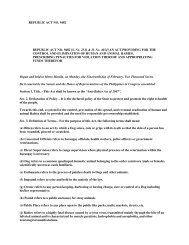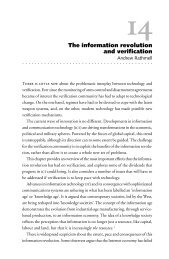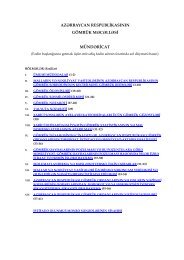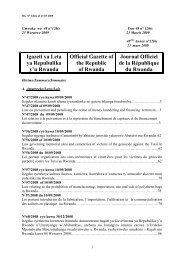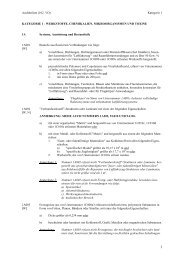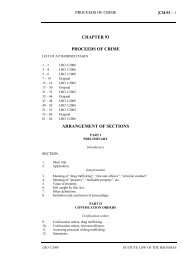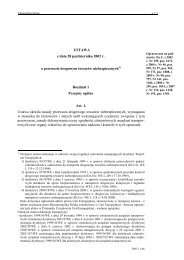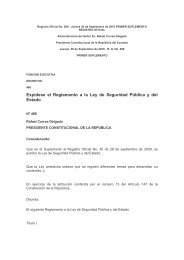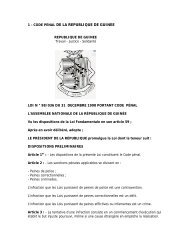Annex I - VERTIC
Annex I - VERTIC
Annex I - VERTIC
You also want an ePaper? Increase the reach of your titles
YUMPU automatically turns print PDFs into web optimized ePapers that Google loves.
▼M2<br />
3. The term ‘noble metal modified aluminide’ coating includes multiple-step<br />
coatings in which the noble metal or noble metals are laid down by some<br />
other coating process prior to application of the aluminide coating.<br />
4. The term ‘mixtures thereof’ includes infiltrated material, graded compositions,<br />
co-deposits and multilayer deposits and are obtained by one or more of<br />
the coating processes specified in the Table.<br />
5. ‘MCrAlX’ refers to a coating alloy where M equals cobalt, iron, nickel or<br />
combinations thereof and X equals hafnium, yttrium, silicon, tantalum in any<br />
amount or other intentional additions over 0,01 % by weight in various<br />
proportions and combinations, except:<br />
a. CoCrAlY coatings which contain less than 22 % by weight of chromium,<br />
less than 7 % by weight of aluminium and less than 2 % by weight of<br />
yttrium;<br />
b. CoCrAlY coatings which contain 22 to 24 % by weight of chromium, 10<br />
to 12 % by weight of aluminium and 0,5 to 0,7 % by weight of yttrium;<br />
or<br />
c. NiCrAlY coatings which contain 21 to 23 % by weight of chromium, 10<br />
to 12 % by weight of aluminium and 0,9 to 1,1 % by weight of yttrium.<br />
6. The term ‘aluminium alloys’ refers to alloys having an ultimate tensile<br />
strength of 190 MPa or more measured at 293 K (20 °C).<br />
7. The term ‘corrosion resistant steel’ refers to AISI (American Iron and Steel<br />
Institute) 300 series or equivalent national standard steels.<br />
8. ‘Refractory metals and alloys’ include the following metals and their alloys:<br />
niobium (columbium), molybdenum, tungsten and tantalum.<br />
9. ‘Sensor window materials’, as follows: alumina, silicon, germanium, zinc<br />
sulphide, zinc selenide, gallium arsenide, diamond, gallium phosphide,<br />
sapphire and the following metal halides: sensor window materials of<br />
more than 40 mm diameter for zirconium fluoride and hafnium fluoride.<br />
10. ‘Technology’ for single-step pack cementation of solid airfoils is not<br />
controlled by Category 2.<br />
11. ‘Polymers’, as follows: polyimide, polyester, polysulphide, polycarbonates<br />
and polyurethanes.<br />
12. ‘Modified zirconia’ refers to additions of other metal oxides (e.g. calcia,<br />
magnesia, yttria, hafnia, rare earth oxides) to zirconia in order to stabilise<br />
certain crystallographic phases and phase compositions. Thermal barrier<br />
coatings made of zirconia, modified with calcia or magnesia by mixing or<br />
fusion, are not controlled.<br />
13. ‘Titanium alloys’ refers only to aerospace alloys having an ultimate tensile<br />
strength of 900 MPa or more measured at 293 K (20 °C).<br />
14. ‘Low-expansion glasses’ refers to glasses which have a coefficient of thermal<br />
expansion of 1 × 10 –7 K –1 or less measured at 293 K (20 °C).<br />
15. ‘Dielectric layers’ are coatings constructed of multi-layers of insulator<br />
materials in which the interference properties of a design composed of<br />
materials of various refractive indices are used to reflect, transmit or<br />
absorb various wavelength bands. Dielectric layers refers to more than<br />
four dielectric layers or dielectric/metal ‘composite’ layers.<br />
2009R0428 — EN — 15.06.2012 — 002.001 — 143



